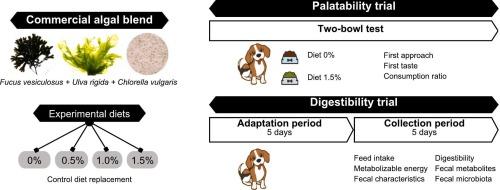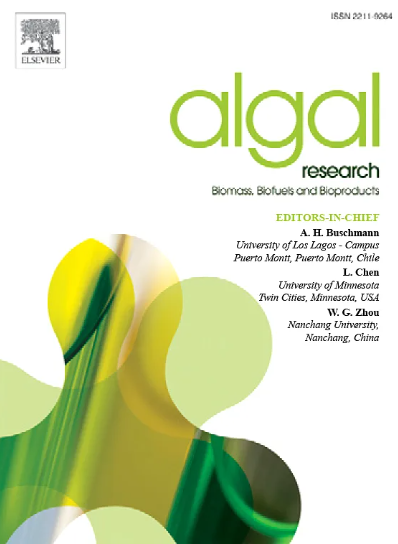狗粮中的大型藻类和微型藻类混合物:对适口性、消化率、粪便代谢物和微生物群的影响
IF 4.6
2区 生物学
Q1 BIOTECHNOLOGY & APPLIED MICROBIOLOGY
Algal Research-Biomass Biofuels and Bioproducts
Pub Date : 2024-10-29
DOI:10.1016/j.algal.2024.103775
引用次数: 0
摘要
宠物主人非常重视促进狗的营养、健康和幸福,这导致人们对含有替代性、功能性和可持续性更强的补充剂(如藻类)的宠物食品越来越感兴趣。很少有研究对狗粮中的单个藻类补充剂进行评估,但没有关于大型藻类和微型藻类组合的信息。本研究评估了由两种大型藻类(石莼和岩藻)和一种微型藻类(小球藻)组成的商用混合藻类膳食补充剂对成年健康比格犬的适口性、摄入量、消化率、代谢能(ME)、粪便特征、代谢物和微生物群的影响。通过比较不含(对照组)藻类和含1.5%藻类混合物的全套饮食,对12只犬的适口性进行了评估。然后,从这些狗中随机挑选六只进行消化率试验。在确定对照组日粮消化率的初步试验后,进行了重复拉丁方试验,三个试验期各为 10 天,藻类混合物的添加量分别为 0.5%、1.0% 和 1.5%。混合藻类食物不影响狗的首次接近和首次品尝,但狗更喜欢对照组食物。藻类混合物水平对摄入量没有影响,但有机物、纤维和能量消化率在添加 1.5 % 时比添加 0.5 % 时有所提高。在最高添加量下,藻类混合物可促进粪便中短链脂肪酸总量和乙酸含量的增加,而在最低添加量下,粪便中丙酸含量减少,粪便产量增加。与对照日粮相比,添加藻类混合物的日粮提高了大部分营养物质和能量的消化率、日粮 ME 含量和粪便质量,同时降低了粪便丁酸盐含量。粪便微生物群的多样性和丰度大多不受藻类混合饲料添加剂的影响,在所有样本中,促进健康的湍流菌属和布劳菌属的数量最多。总之,研究结果表明,混合藻类是一种很有前景的狗粮替代添加剂,但要揭示其潜在的健康促进作用,还需要进一步的研究。本文章由计算机程序翻译,如有差异,请以英文原文为准。

Macroalgae and microalga blend in dogs' food: Effects on palatability, digestibility, and fecal metabolites and microbiota
The promotion of dogs' nutrition, health, and well-being are highly valued by pet owners, leading to an increasing interest in pet food with alternative, functional, and more sustainable supplements, such as algae. Few studies have assessed the supplementation of dog food with individual algae species, but no information exists on combined macro- and microalgae. This study evaluated the effects of dietary supplementation of a commercial algal blend, composed of two macroalgae (Ulva rigida and Fucus vesiculosus) and one microalga (Chlorella vulgaris) on palatability, intake, digestibility, metabolizable energy (ME), and fecal characteristics, metabolites, and microbiota of adult healthy Beagle dogs. Palatability was assessed by comparing a complete diet without (control) and with 1.5 % algae blend using twelve dogs. Then, six of these dogs were randomly selected for the digestibility trials. Following an initial trial to determine the control diet digestibility, a replicated Latin square was performed with three experimental periods of 10 days each, and three algal blend supplementation levels (0.5, 1.0, and 1.5 %). Dietary algal blend did not affect the first approach and first taste, but dogs preferred the control diet. Algal blend levels had no impact on intake, but organic matter, fiber, and energy digestibility increased with 1.5 % inclusion compared with 0.5 %. At the highest level, algae blend promoted fecal total short chain fatty acids and acetate while at lowest fecal propionate decreased and fecal production increased. Compared with the control diet, algal blend-supplemented diets promoted most nutrients and energy digestibility, diet ME content, and fecal quality, while reducing fecal butyrate. Fecal microbiota diversity and abundance were mostly unaffected by algae blend supplementation, with health-promoting genera Turicibacter and Blautia being the most abundant in all samples. Overall, results suggest algal blend as a promising alternative supplement for dog food, but further research is needed to unveil potential health-promoting effects.
求助全文
通过发布文献求助,成功后即可免费获取论文全文。
去求助
来源期刊

Algal Research-Biomass Biofuels and Bioproducts
BIOTECHNOLOGY & APPLIED MICROBIOLOGY-
CiteScore
9.40
自引率
7.80%
发文量
332
期刊介绍:
Algal Research is an international phycology journal covering all areas of emerging technologies in algae biology, biomass production, cultivation, harvesting, extraction, bioproducts, biorefinery, engineering, and econometrics. Algae is defined to include cyanobacteria, microalgae, and protists and symbionts of interest in biotechnology. The journal publishes original research and reviews for the following scope: algal biology, including but not exclusive to: phylogeny, biodiversity, molecular traits, metabolic regulation, and genetic engineering, algal cultivation, e.g. phototrophic systems, heterotrophic systems, and mixotrophic systems, algal harvesting and extraction systems, biotechnology to convert algal biomass and components into biofuels and bioproducts, e.g., nutraceuticals, pharmaceuticals, animal feed, plastics, etc. algal products and their economic assessment
 求助内容:
求助内容: 应助结果提醒方式:
应助结果提醒方式:


